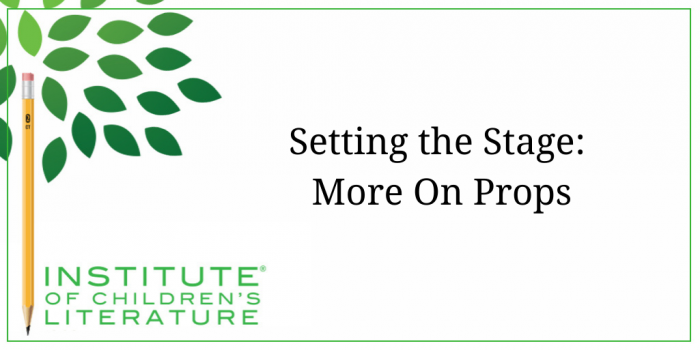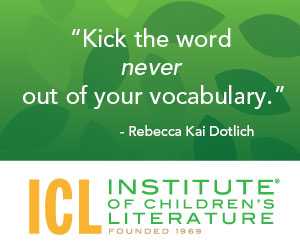1000 N. West Street #1200, Wilmington, DE 19801
© 2024 Direct Learning Systems, Inc. All rights reserved.

As a small child, my daughter had a favorite teddy bear that we named “Grubby,” because he so often was. She took Grubby everywhere and learned to do the most impressive things with a teddy bear tucked firmly under her arm. She could climb rope ladders and scramble up climbing walls with Grubby tucked in his spot. Everyone who knew my daughter, knew Grubby. If my daughter had been a fictional character, that grubby old bear would have been an integral part of her characterization, just as Knuffle Bunny was an integral part of Trixie’s characterization in the titular Mo Willems book. Grubby, like Knuffle Bunny, was a prop that revealed important things about the character connected with it.
A prop can be all manner of things. A hat can be a prop. The Cat in the Hat, for example, would have been less zany without that crazy hat. And in the Curious George books, the yellow hat of George’s friend was essential to who he was. The sort of hat a person chooses to wear shows us things about their personality (and can also be a marker for a character’s occupation).

Of course, hats are just one possible prop. Favorite clothes, favorite toys, favorite books can all be important characterization and plot elements. And this isn’t just an element for picture books.
Collections can be essential props in middle grade novels to reflect the age when many children are fond of collecting. What will your character choose to collect? A character who collects seashells is going to be a different sort of child from one who collects hats. And a child who collects animal bones is going to be a unique child indeed. For one example of an unexpected collection in a picture book, check out The Word Collector by Peter H. Reynolds. In it, Jerome’s collection is influenced by both the kind of child he is, and the things he enjoys doing. Being a word collector makes Jerome a unique character.
In fact, props are such valuable ways to approach character creation from a new angle, that it might be worthwhile to make it part of the normal process. You don’t need to feel bound to the prop choice. In fact, you might eliminate the item later when you actually launch into the story, but by brainstorming around a prop, you have a different way to think about the character. So consider doing some browsing at your local thrift store or at yard sales and try to imagine a child who would love that strange little stuffie you found, or who would value some odd knick-knack above all else. What kind of child would that be? What could lead to the attachment? How might an attachment to a weird collection or odd hat affect the character’s interactions with other characters?
Here’s another writing exercise. Try making a list of all the possible things you can think of that might be props. I’ve mentioned hats and collections, but what other things can you think of?

Or vintage buttons that the character doesn’t quite understand, so she makes up her own meaning for them?
Or maybe the denim jacket that belonged to an older brother who is away in the military?
How many things can you think of?
Don’t stop with a half dozen, push yourself to fill a page with possible props. Go ahead and get silly with some of them.
Once you have a nice long list, you can ponder each one to see if one of them leaps off the page and wants to be part of your character creation process, building backstory around the character and the item. Or you might want to cut your list into bits and fill a jar with them. Then pull one each day and do a speed writing where you just brainstorm about the character who values this thing deeply. You may be amazed at what you discover while doing this. Often hanging your writing exercises on things like this will take you in directions your regular brainstorming never would, and you’ll come up with something wildly new that you want to pursue into a story.
So what do you think? What’s the most interesting prop you can come up with off the top of your head? And where might it take you? I think you just might find an adventure in there.
With over 100 books in publication, Jan Fields writes both chapter books for children and mystery novels for adults. She’s also known for a variety of experiences teaching writing, from one session SCBWI events to lengthier Highlights Foundation workshops to these blog posts for the Institute of Children’s Literature. As a former ICL instructor, Jan enjoys equipping writers for success in whatever way she can.
1000 N. West Street #1200, Wilmington, DE 19801
© 2024 Direct Learning Systems, Inc. All rights reserved.
1000 N. West Street #1200, Wilmington, DE 19801
© 2024 Direct Learning Systems, Inc. All rights reserved.
1000 N. West Street #1200, Wilmington, DE 19801
© 2024 Direct Learning Systems, Inc. All rights reserved.
1000 N. West Street #1200, Wilmington, DE 19801
© 2024 Direct Learning Systems, Inc. All rights reserved.

1000 N. West Street #1200, Wilmington, DE 19801
© 2025 Direct Learning Systems, Inc. All rights reserved.

1000 N. West Street #1200, Wilmington, DE 19801
©2025 Direct Learning Systems, Inc. All rights reserved. Privacy Policy.
2 Comments